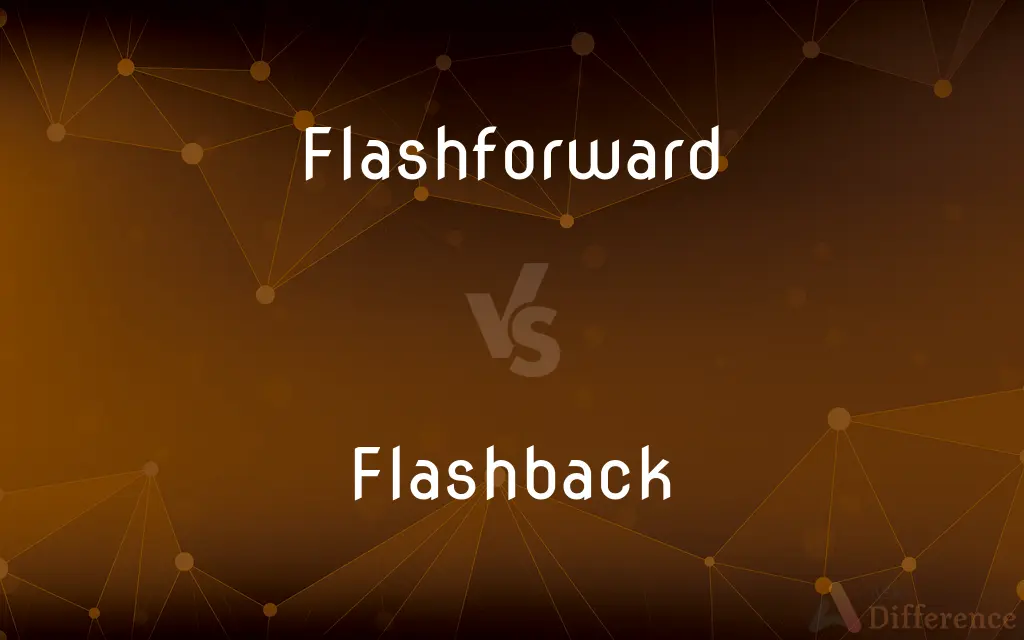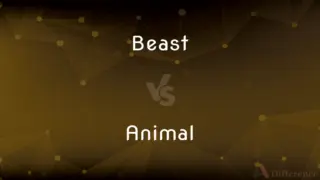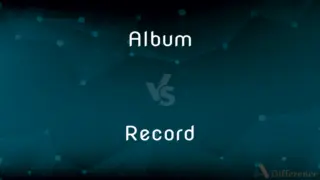Flashforward vs. Flashback — What's the Difference?
Edited by Tayyaba Rehman — By Fiza Rafique — Updated on May 5, 2024
Flashforward involves scenes depicting events expected to occur in the future, emphasizing anticipation and foreshadowing, whereas a flashback provides a retrospective view to past events, offering context and backstory.

Difference Between Flashforward and Flashback
Table of Contents
ADVERTISEMENT
Key Differences
Flashforwards transport the audience into the future of the storyline, creating a narrative tension as viewers anticipate how current events will lead to that future scenario. On the other hand, flashbacks delve into a character's past or earlier events within the story, serving to reveal motivations, backstory, or hidden relationships that inform the current narrative circumstances.
While flashforwards are used to set up expectations and often build suspense about forthcoming developments, flashbacks are primarily employed to provide context or explain why characters behave in certain ways in the present. This contrast in usage directly influences how stories unfold and how audiences engage with the narrative.
Flashforwards can also be a storytelling device to challenge viewers' understanding of the narrative timeline, by presenting a puzzle or a piece of a timeline that the viewers must fit into the established story. Whereas flashbacks are often more straightforward, aimed at filling in gaps in the story or deepening understanding of the narrative or character development.
In terms of emotional impact, flashforwards can evoke curiosity and anticipation, keeping audiences hooked on the possibilities of what could happen next. In contrast, flashbacks might evoke nostalgia or empathy, allowing audiences to form deeper emotional connections with the characters by understanding their histories.
Both flashforwards and flashbacks can be used strategically to enhance the storytelling by manipulating time and perspective. However, the key difference lies in their direction of time travel — forward for foreshadowing future events and backward for revealing past actions.
ADVERTISEMENT
Comparison Chart
Direction of Time
Moves narrative forward to the future
Takes narrative back to the past
Purpose
To create anticipation and foreshadow future events
To provide backstory and contextual understanding
Usage in Plot
Often used to build suspense or set expectations
Used to fill narrative gaps or deepen character arcs
Emotional Impact
Generates curiosity and speculation
Evokes nostalgia or empathy
Narrative Effect
Challenges audience's understanding of timeline
Aids in understanding motivations and relationships
Compare with Definitions
Flashforward
Often serves as a dramatic or mysterious element.
The series used a flashforward to hint at the fate of its main character.
Flashback
A part of the narrative that transports the story back in time from the current point.
The flashback to her childhood provided insight into her fears.
Flashforward
Used to connect the future with the present narrative.
The flashforward provided clues about the protagonist’s ultimate decision.
Flashback
Often provides critical backstory or character motivation.
Through flashbacks, we learn about the villain’s troubled past.
Flashforward
A scene in a story that jumps ahead of the current timeline to show future events.
In the movie, a flashforward shows the protagonist as a successful businessman, hinting at his eventual triumph.
Flashback
Can vary in length from a few moments to an entire episode.
The entire episode was a flashback explaining the origins of the conflict.
Flashforward
A narrative technique used to create suspense or foreshadow.
The novel’s flashforward teased the looming disaster before returning to present events.
Flashback
Enhances emotional depth and understanding.
The flashback scenes added layers to the character’s personality.
Flashforward
Can be a glimpse or an extended sequence.
A brief flashforward in the play reveals the tragic outcome of the hero’s journey.
Flashback
Used to reveal past events that shape the current storyline.
A series of flashbacks in the film showed the hero’s motivation for revenge.
Flashforward
A flashforward (also spelled flash-forward, and more formally known as prolepsis) is a scene that temporarily takes the narrative forward in time from the current point of the story in literature, film, television and other media. Flashforwards are often used to represent events expected, projected, or imagined to occur in the future.
Flashback
A literary or cinematic device in which an earlier event is inserted into the normal chronological order of a narrative.
Flashforward
(authorship) A dramatic device in which a future event is inserted into the normal chronological flow of a narrative.
Flashback
The episode or scene depicted by means of this device.
Flashforward
To use this dramatic device.
Flashback
(Psychiatry) A recurring, intensely vivid mental image of a past traumatic experience
Soldiers who had flashbacks of the war.
Flashback
An unexpected recurrence of the effects of a hallucinogenic drug long after its original use.
Flashback
A vivid memory that arises spontaneously or is provoked by an experience.
Flashback
An experience that has characteristics of an earlier experience.
Flashback
(authorship) A dramatic device in which an earlier event is inserted into the normal chronological flow of a narrative.
Flashback
(psychology) A vivid mental image of a past trauma or other sensation that the trauma is happening in the present, especially one that recurs.
Flashback
A similar recurrence of the effects of a hallucinogenic drug.
Flashback
The condition of the flame propagating down the hose of an oxy-fuel welding system.
Flashback
(databases) A query that operates against data from an earlier time, before it was changed.
Flashback
(intransitive) To undergo a flashback; to experience a vivid mental image from the past.
Flashback
A transition (in literary or theatrical works or films) to an earlier event or scene; also, the scene thus introduced.
Flashback
An unusually vivid recollection of a prior experience, often one that is traumatic, such as scenes from combat or a criminal assault, or induced by hallucinogenic drugs such as LSD; when accompanied by hallucinations it is called flashback hallucinosis.
Flashback
A transition (in literary or theatrical works or films) to an earlier event or scene that interrupts the normal chronological development of the story
Flashback
An unexpected but vivid recurrence of a past experience (especially a recurrence of the effects of an hallucinogenic drug taken much earlier)
Common Curiosities
What is a flashforward?
A flashforward is a scene that temporarily takes the narrative forward in time to depict potential future events.
Can a flashback affect the emotional tone of a story?
Yes, flashbacks can deeply affect the emotional tone by revealing motivations, past traumas, or significant events that shape a character’s current actions.
How does a flashback differ from a flashforward?
A flashback looks back at past events to provide backstory or context, whereas a flashforward looks ahead to suggest upcoming events.
Why do authors use flashforwards?
Authors use flashforwards to manipulate the pacing of the story, create suspense, and engage the audience by teasing future outcomes.
How do flashbacks contribute to the plot?
Flashbacks contribute by filling gaps in the storyline, offering insights into character relationships, and setting up plot revelations.
What is the purpose of a flashforward in storytelling?
The main purpose of a flashforward is to build suspense, create anticipation, or foreshadow future events in a story.
Are flashforwards common in all genres of storytelling?
Flashforwards are more common in genres like science fiction, thrillers, and mystery, where building suspense and challenging narrative structure are key elements.
How does the length of a flashforward affect its impact?
The length of a flashforward can affect its impact by either offering a quick tease of future events or providing a deeper, more complex glimpse into the future.
What is the impact of using a flashback on character development?
Flashbacks can greatly enhance character development by revealing their past experiences and the reasons behind their current behavior.
What is a key narrative challenge when using flashbacks?
Maintaining narrative flow and coherence while integrating past events smoothly into the current storyline is a key challenge.
In what ways can flashbacks deepen the audience's understanding of a story?
Flashbacks can deepen understanding by exposing hidden histories, clarifying motivations, and revealing secrets that shape the plot.
What types of narratives benefit most from flashforwards?
Narratives that involve complex plots or those that play with temporal structures benefit most from the use of flashforwards.
How do viewers typically react to flashforwards in a film or TV series?
Viewers often react with increased curiosity and engagement, as flashforwards challenge them to predict how the story will unfold.
Can flashbacks and flashforwards be used together in a story?
Yes, both devices can be effectively combined to enhance the narrative complexity and enrich the storytelling experience.
How can filmmakers effectively implement flashforwards?
Filmmakers can effectively implement flashforwards by ensuring they are seamlessly integrated into the narrative and contribute meaningfully to the development of the plot and characters.
Share Your Discovery

Previous Comparison
Beast vs. Animal
Next Comparison
Album vs. RecordAuthor Spotlight
Written by
Fiza RafiqueFiza Rafique is a skilled content writer at AskDifference.com, where she meticulously refines and enhances written pieces. Drawing from her vast editorial expertise, Fiza ensures clarity, accuracy, and precision in every article. Passionate about language, she continually seeks to elevate the quality of content for readers worldwide.
Edited by
Tayyaba RehmanTayyaba Rehman is a distinguished writer, currently serving as a primary contributor to askdifference.com. As a researcher in semantics and etymology, Tayyaba's passion for the complexity of languages and their distinctions has found a perfect home on the platform. Tayyaba delves into the intricacies of language, distinguishing between commonly confused words and phrases, thereby providing clarity for readers worldwide.













































